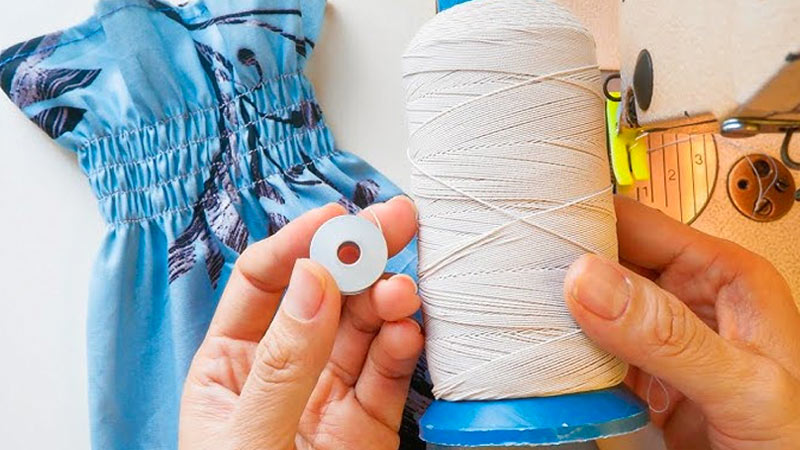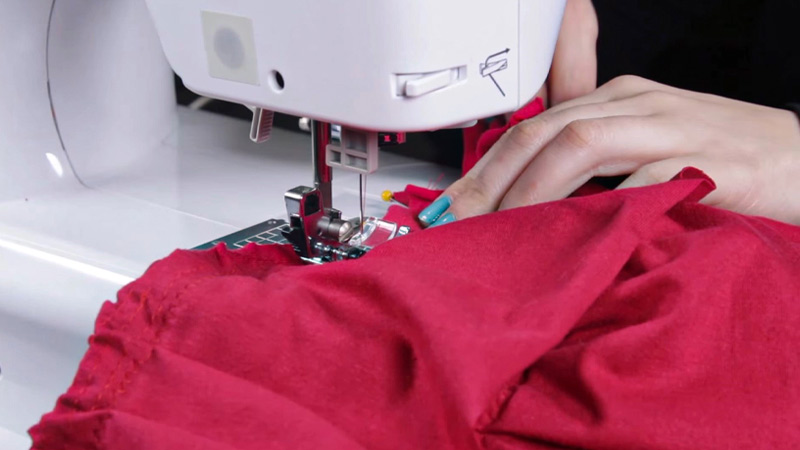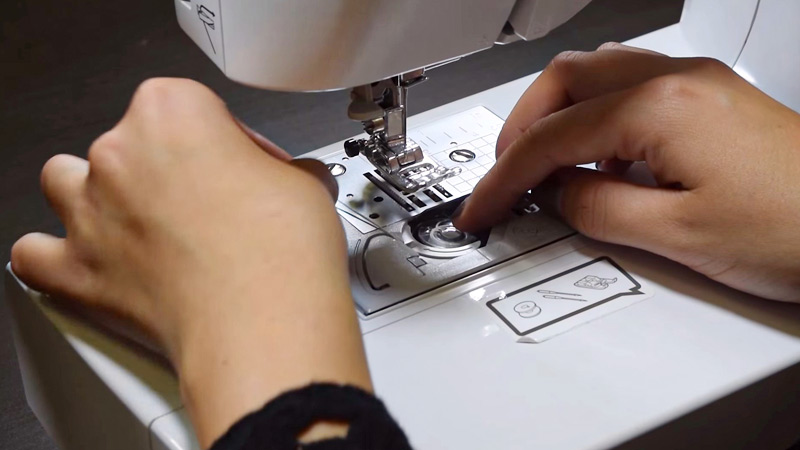Sewing with elastic thread introduces a world of versatility and creativity into the realm of sewing.
This specialized technique allows you to add stretch, texture, and unique design elements to your fabric projects, whether you’re crafting comfortable waistbands or transforming plain fabric into shirred wonders.
To embark on this exciting journey, it’s essential to gather the right supplies. From the elastic thread itself to the supporting tools and materials, each component plays a crucial role in the success of your elastic thread sewing projects.
In this comprehensive guide, we will explore supplies for sewing with elastic thread, offering insights into their significance and how they contribute to the art of creating gathered, stretchy, and stylish fabric creations.

Supplies For Sewing With Elastic Thread
Sewing with elastic thread opens up a world of creative possibilities, whether you’re adding shirring to a dress or creating comfortable waistbands on garments. To ensure a successful elastic thread sewing project, you’ll need specific supplies.
Here are seven essential items:
Elastic Thread
Elastic thread, often referred to as shirring elastic, is the heart of your project. It’s a special type of stretchable thread that gathers fabric when stitched.
Choose high-quality elastic thread for durability and consistent results.
Regular Thread
You’ll also need regular sewing thread in a matching or complementary colour to secure seams, finish edges, and attach any non-elastic parts of your project.
Sewing Machine

A sewing machine is essential for sewing with elastic thread. Make sure your machine is in good working condition and properly threaded for both the upper thread (regular thread) and the bobbin (elastic thread).
Fabric
Select a fabric that is compatible with elastic thread shirring. Lightweight, breathable materials like cotton, voile, or jersey work well. Ensure the fabric has some stretch to achieve the desired gathering effect.
Bobbin Winders
Some sewing machines come with a separate bobbin winder. If not, you may need a handheld bobbin winder to wind elastic thread onto the bobbin evenly and loosely.
Needles
Use needles specifically designed for elastic thread or shirring. These needles have larger eyes to accommodate the thicker thread and are often labelled as “elastic” or “shirring” needles.
Iron and Ironing Board
An iron and ironing board are essential for pressing and setting your shirred fabric. This step helps the elastic thread gather the fabric effectively and creates a neat finish.
With these seven essential supplies, you’ll be well-equipped to embark on sewing projects that involve elastic thread, such as shirred dresses, tops, and skirts.
Properly chosen materials and tools are key to achieving professional-looking gathers and comfortable, stretchy elements in your sewing creations.
How To Sew With Elastic Thread?

Sewing with elastic thread can transform your fabric projects by adding stretch and texture.
Here are the simple steps to guide you through the process:
Prepare Your Machine
Wind a bobbin with elastic thread. Adjust your sewing machine’s tension settings for the elastic thread, usually by lowering the upper thread tension.
Thread Your Machine
Thread your sewing machine with regular thread in the needle and the bobbin wound with elastic thread. Make sure the elastic thread is loosely wound on the bobbin.
Prepare Your Fabric
Cut your fabric to the desired size for your project. Ensure that the fabric is clean, flat, and properly prepared for sewing.
Mark Your Stitch Lines
Use fabric markers or chalk to mark the lines where you want to shirr or gather the fabric. These lines serve as a guide for your stitching.
Start Stitching
Begin sewing along the marked lines, using a straight stitch or a decorative stitch of your choice. Make sure to backstitch at the beginning and end to secure the stitches.
Tension and Stitch Length
Maintain consistent tension on the elastic thread as you sew. Adjust the stitch length to achieve your desired gathering effect. Longer stitches result in more prominent gathers.
Steam and Set the Gathers
After stitching, use steam from an iron to shrink and set the elastic thread. Hold the iron close to, but not touching, the fabric, and watch as the fabric gathers.
Stretch and Distribute Gathers
To ensure an even distribution of gathers, gently stretch the shirred area with your hands. This step helps balance the gathers for a uniform appearance.
By following these steps, you can successfully sew with elastic thread and create beautiful shirring effects on your fabric projects.
Whether you’re adding stretchy waistbands to skirts, creating stylish tops, or embellishing garments, mastering this technique will allow you to achieve professional and eye-catching results.
Practice and experimentation will help you refine your skills and unlock the full potential of sewing with elastic thread.
Sewing With Elastic Thread – Machine Settings

Sewing with elastic thread requires specific machine settings to ensure your project turns out well.
Here are the crucial machine settings and their descriptions for sewing with elastic thread:
Thread Tension
Lower the upper thread tension on your sewing machine to its lowest setting. This adjustment allows the elastic thread to pull the fabric into gathers effectively.
Test the tension on a scrap piece of fabric to ensure it’s not too tight or too loose.
Stitch Length
Choose a longer stitch length to create more pronounced gathers. A longer stitch length provides more space between the elastic thread stitches, resulting in larger and more visible shirring.
Stitch Selection
While a straight stitch is commonly used for shirring, you can experiment with decorative stitches if your sewing machine offers them. Ensure that the chosen stitch accommodates the elastic thread and fabric stretch.
Presser Foot Pressure
Reduce the presser foot pressure if your sewing machine allows it. This adjustment helps prevent the fabric from stretching or puckering while sewing with elastic thread.
Needle Type and Size
Use a special elastic or shirring needle designed for sewing with elastic thread. These needles have larger eyes to accommodate the thicker thread. Opt for a needle size appropriate for your fabric weight.
Bobbin Winding
Wind the bobbin with elastic thread, making sure it’s loosely wound to prevent excessive tension. Some sewing machines may require you to hand-wind the bobbin to achieve the desired tension.
Machine Speed
Sew at a moderate and consistent speed to maintain control over the fabric and elastic thread. Avoid sewing too quickly, as it can lead to uneven gathers or thread breakage.
By adjusting these machine settings appropriately, you can sew with elastic thread smoothly and achieve the desired shirring effect.
Remember to practice on scrap fabric to fine-tune your settings and ensure the best results for your specific project.
With the right machine settings, you’ll be able to create beautifully gathered and stretchy fabric elements in your sewing projects.
FAQ
For sewing with elastic thread, you’ll need specialized elastic thread, also known as shirring elastic. This thread has the stretch and resilience necessary for creating gathered and stretchy fabric effects.
No, regular sewing thread isn’t a suitable substitute for elastic thread when shirring or sewing with elastic.
Elastic thread has unique properties that allow it to gather fabric, while regular thread lacks the necessary stretch.
Yes, it’s advisable to use shirring or elastic needles. These needles have larger eyes to accommodate the thicker elastic thread and prevent damage to your sewing machine.
It’s best to choose fabrics with some natural stretch, such as cotton or jersey, for elastic thread sewing. Fabrics with no stretch may not gather effectively.
Yes, you’ll need a set of complementary tools, including an iron, bobbin winders, regular sewing thread, and, of course, a sewing machine, to successfully complete your elastic thread sewing projects. These tools support and enhance your sewing experience.
Conclusion
The supplies for sewing with elastic thread form the foundation of your creative sewing endeavors.
Whether you’re looking to craft trendy shirred garments, flexible waistbands, or stretchy accessories, having the right materials at your disposal is essential.
Elastic thread, regular thread, sewing machines, fabric, bobbin winders, shirring needles, and irons collectively enable you to transform ordinary fabric into extraordinary creations.
As you gather and master these supplies, you’ll unlock the potential to add comfort, style, and unique design elements to your sewing projects.
So, embrace the world of elastic thread sewing and let your creativity flow with the support of these indispensable supplies, turning your fabric visions into stunning, stretchy realities.
Leave a Reply